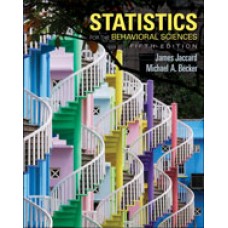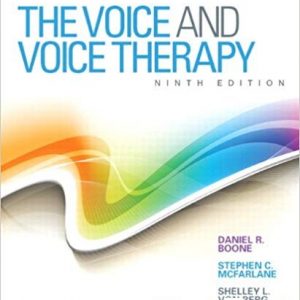This is completed downloadable of Test Bank for Statistics for the Behavioral Sciences, 5th Edition

Product Details:
- ISBN-10 : 131919074X
- ISBN-13 : 978-1319190743
- Author:
Nolan and Heinzen offer an introduction to the basics of statistics that is uniquely suited for behavioral science students due to its coverage that is anchored in real-world stories, its highly visual approach to presenting data, helpful mathematical and formula support, and its unique immersive learning activities (Which Test is Best and the new Interpreting Statistical Results) right in LaunchPad. The latest edition includes information in every chapter about data ethics, including the movement towards open science
Table of Content:
- Chapter 1 An Introduction to Statistics and Research Design
- The Two Branches of Statistics
- Descriptive Statistics
- Inferential Statistics
- Distinguishing Between a Sample and a Population
- How to Transform Observations into Variables
- Discrete Observations
- Continuous Observations
- Variables and Research
- Independent, Dependent, and Confounding Variables
- Reliability and Validity
- Introduction to Hypothesis Testing
- Correlational Studies and the Danger of Confounding Variables
- Conducting Experiments to Control for Confounding Variables
- Between-Groups Design Versus Within-Groups Design
- Introduction to Data Ethics
- Data Ethics: Preregistration
- Review of Concepts
- SPSS
- Exercises
- Terms
- Chapter 2 Frequency Distributions
- Frequency Distributions
- Frequency Tables
- Grouped Frequency Tables
- Histograms
- Shapes of Distributions
- Normal Distributions
- Skewed Distributions
- Data Ethics: Dot Plots and the Importance of Seeing Individual Data Points
- Review of Concepts
- SPSS
- How it Works
- Exercises
- Terms
- Chapter 3 Visual Displays of Data
- The Power of Graphs
- “The Most Misleading Graph Ever Published”
- Data Ethics: How to Lie with Graphs
- Common Types of Graphs
- Scatterplots
- Line Graphs
- Bar Graphs
- Pictorial Graphs
- Pie Charts
- How to Build a Graph
- Choosing the Appropriate Type of Graph
- How to Read a Graph
- Guidelines for Creating a Graph
- The Future of Graphs
- Review of Concepts
- SPSS
- How it Works
- Exercises
- Terms
- Chapter 4 Central Tendency and Variability
- Central Tendency
- Mean: The Arithmetic Average
- Median: The Middle Score
- Mode: The Most Common Score
- How Outliers Affect Measures of Central Tendency
- Data Ethics: Being Fair with Central Tendency
- Measures of Variability
- Range
- The Interquartile Range
- Variance
- Standard Deviation
- Review of Concepts
- SPSS
- How it Works
- Exercises
- Terms
- Chapter 5 Sampling and Probability
- Samples and Their Populations
- Random Sampling
- Convenience Sampling
- The Problem with a Biased Sample
- Random Assignment
- Probability
- Coincidence and Probability
- Expected Relative-Frequency Probability
- Independence and Probability
- Inferential Statistics
- Developing Hypotheses
- Making a Decision About a Hypothesis
- Type I and Type II Errors
- Type I Errors
- Type II Errors
- Data Ethics: The Shocking Prevalence of Type I Errors
- Review of Concepts
- SPSS
- How it Works
- Exercises
- Terms
- Chapter 6 The Normal Curve, Standardization, and z Scores
- The Normal Curve
- Standardization, z Scores, and the Normal Curve
- The Need for Standardization
- Transforming Raw Scores into z Scores
- Transforming z Scores into Raw Scores
- Using z Scores to Make Comparisons
- Transforming z Scores into Percentiles
- The Central Limit Theorem
- Creating a Distribution of Means
- Characteristics of the Distribution of Means
- Using the Central Limit Theorem to Make Comparisons with z Scores
- Data Ethics: Using z Scores to Keep Researchers Honest
- Review of Concepts
- SPSS
- How it Works
- Exercises
- Terms
- Chapter 7 Hypothesis Testing with z Tests
- The z Table
- Raw Scores, z Scores, and Percentages
- The z Table and Distributions of Means
- The Assumptions and Steps of Hypothesis Testing
- The Three Assumptions for Conducting Analyses
- The Six Steps of Hypothesis Testing
- An Example of the z Test
- Data Ethics: HARKing and p-Hacking
- Review of Concepts
- SPSS
- How it Works
- Exercises
- Terms
- Chapter 8 Confidence Intervals, Effect Size, and Statistical Power
- The New Statistics
- Confidence Intervals
- Interval Estimates
- Calculating Confidence Intervals with z Distributions
- Effect Size
- The Effect of Sample Size on Statistical Significance
- What Effect Size Is
- Cohen’s d
- Meta-Analysis
- Statistical Power
- Making Correct Decisions
- Five Factors That Affect Statistical Power
- Data Ethics: Sample Size Planning
- Review of Concepts
- How it Works
- Exercises
- Terms
- Chapter 9 The Single-Sample t Test
- The t Distributions
- Estimating Population Standard Deviation from a Sample
- Calculating Standard Error for the t Statistic
- Using Standard Error to Calculate the t Statistic
- The Single-Sample t Test
- The t Table and Degrees of Freedom
- The Six Steps of the Single-Sample t Test
- Calculating a Confidence Interval for a Single-Sample t Test
- Calculating Effect Size for a Single-Sample t Test
- Data Ethics: Replication and Reproducibility
- Review of Concepts
- SPSS
- How it Works
- Exercises
- Terms
- Chapter 10 The Paired-Samples t Test
- The Paired-Samples t Test
- Distributions of Mean Differences
- The Six Steps of the Paired-Samples t Test
- Beyond Hypothesis Testing
- Calculating a Confidence Interval for a Paired-Samples t Test
- Calculating Effect Size for a Paired-Samples t Test
- Data Ethics: Avoiding Order Effects Through Counterbalancing
- Review of Concepts
- SPSS
- How it Works
- Exercises
- Terms
- Chapter 11 The Independent-Samples t Test
- Conducting an Independent-Samples t Test
- A Distribution of Differences Between Means
- The Six Steps of the Independent-Samples t Test
- Reporting the Statistics
- Beyond Hypothesis Testing
- Calculating a Confidence Interval for an Independent-Samples t Test
- Calculating Effect Size for an Independent-Samples t Test
- Data Ethics: The Bayesian Approach to Data Analysis
- Review of Concepts
- SPSS
- How it Works
- Exercises
- Terms
- Chapter 12 One-Way Between-Groups ANOVA
- Using the F Distributions with Three or More Samples
- Type I Errors When Making Three or More Comparisons
- The F Statistic as an Expansion of the z and t Statistics
- The F Distributions for Analyzing Variability to Compare Means
- The F Table
- The Language and Assumptions for ANOVA
- One-Way Between-Groups ANOVA
- Everything About ANOVA But the Calculations
- The Logic and Calculations of the F Statistic
- Making a Decision
- Beyond Hypothesis Testing for the One-Way Between-Groups ANOVA
- R2 and Omega Squared, Effect Sizes for ANOVA
- Post Hoc Tests
- The Tukey HSD Test
- Data Ethics: The Bonferroni Test
- Review of Concepts
- SPSS
- How it Works
- Exercises
- Terms
- Chapter 13 One-Way Within-Groups ANOVA
- One-Way Within-Groups ANOVA
- The Benefits of Within-Groups ANOVA
- The Six Steps of Hypothesis Testing
- Beyond Hypothesis Testing for the One-Way Within-Groups ANOVA
- R2, the Effect Size for ANOVA
- The Tukey HSD Test
- Data Ethics: “WEIRD” Samples and Good Reporting Practices
- Review of Concepts
- SPSS
- How it Works
- Exercises
- Terms
- Chapter 14 Two-Way Between-Groups ANOVA
- Two-Way ANOVA
- Why We Use Two-Way ANOVA
- The More Specific Vocabulary of Two-Way ANOVA
- Two Main Effects and an Interaction
- Understanding Interactions in ANOVA
- Interactions and Public Policy
- Interpreting Interactions
- Conducting a Two-Way Between-Groups ANOVA
- The Six Steps of Two-Way ANOVA
- Identifying Four Sources of Variability in a Two-Way ANOVA
- Effect Size for Two-Way ANOVA
- Variations on ANOVA
- Data Ethics: How Data Detectives Fact-Check Statistics
- Review of Concepts
- SPSS
- How it Works
- Exercises
- Terms
- Chapter 15 Correlation
- The Meaning of Correlation
- The Characteristics of Correlation
- Correlation Is Not Causation
- The Pearson Correlation Coefficient
- Calculating the Pearson Correlation Coefficient
- Hypothesis Testing with the Pearson Correlation Coefficient
- Partial Correlation
- Data Ethics: Correlation, Causation, and Big Data
- Applying Correlation in Psychometrics
- Reliability
- Validity
- Review of Concepts
- SPSS
- How it Works
- Exercises
- Terms
- Chapter 16 Regression
- Simple Linear Regression
- Prediction Versus Relation
- Regression with z Scores
- Determining the Regression Equation
- The Standardized Regression Coefficient and Hypothesis Testing with Regression
- Interpretation and Prediction
- Regression and Error
- Applying the Lessons of Correlation to Regression
- Regression to the Mean
- Multiple Regression
- Understanding the Equation
- Multiple Regression in Everyday Life
- Data Ethics: Ethical Landmines in Predicting Individual Behavior
- Review of Concepts
- SPSS
- How it Works
- Exercises
- Terms
- Chapter 17 Chi-Square Tests
- Nonparametric Statistics
- An Example of a Nonparametric Test
- When to Use Nonparametric Tests
- Chi-Square Tests
- Chi-Square Test for Goodness of Fit
- Chi-Square Test for Independence
- Adjusted Standardized Residuals
- Beyond Hypothesis Testing
- Cramér’s V, the Effect Size for Chi Square
- Graphing Chi-Square Percentages
- Data Ethics: Relative Risk
- Review of Concepts
- SPSS
- How it Works
- Exercises
- Terms
- Chapter 18 Choosing and Reporting Statistics
- Choosing the Right Statistical Test
- Category 1: Two Scale Variables
- Category 2: Nominal Independent Variable(s) and a Scale Dependent Variable
- Category 3: Only Nominal Variables
- Reporting Statistics
- Overview of Reporting Statistics
- Justifying the Study
- Reporting the Traditional and the New Statistics
- Data Ethics: Open Data Practices
- Review of Concepts
- How it Works
- Exercises
- Appendix A: Reference for Basic Mathematics
- Appendix B: Statistical Tables
- Appendix C: Solutions to Odd-Numbered End-of-Chapter Problems
- Appendix D: Check Your Learning Solutions
- Glossary
- References
- Index
- Formulas
- Back Cover





